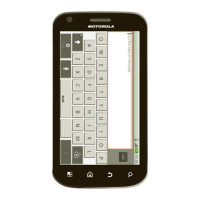56
Your mobile device can also use Assisted Global Positioning System (AGPS), which
obtains information from the mobile network to improve GPS performance. AGPS
uses your wireless service provider's network and therefore airtime, data charges
and/or additional charges may apply in accordance with your service plan. Contact
your wireless service provider for details.
Your location
Location-based information includes information that can be used to determine the
approximate location of a mobile device. Mobile devices that are connected to a
wireless network transmit location-based information. Devices enabled with GPS or
AGPS technology also transmit location-based information. Additionally, if you use
applications that require location-based information (e.g. driving directions), such
applications transmit location-based information. This location-based information
may be shared with third parties, including your wireless service provider,
applications providers, Motorola and other third parties providing services.
Emergency calls
When you make an emergency call, the mobile network may activate the AGPS
technology in your mobile device to tell the emergency responders your approximate
location.
AGPS has limitations and
might not work in your area
. Therefore:
•
Always tell the emergency responder your location to the best of your ability; and
•
Remain on the phone for as long as the emergency responder instructs you.
Performance tips
•
Go outside and away from underground locations, covered vehicles, structures
with metal or concrete roofs, tall buildings and foliage. Indoor performance might
improve if you move closer to windows, but some window sun shielding films
can block satellite signals.
•
Move away from radios, entertainment equipment and other electronic devices.
Navigation
Navigation
When using navigation features, note that mapping information, directions and
other navigational data may contain inaccurate or incomplete data. In some
countries, complete information may not be available. Therefore, you should visually
confirm that the navigational instructions are consistent with what you see. All
drivers should pay attention to road conditions, closures, traffic and all other factors
that may impact driving. Always obey posted road signs.
Smart practices while driving
Driving safety
Check the laws and regulations on the use of mobile devices and their
accessories in the areas where you drive. Always obey them. The use of
these devices may be prohibited or restricted in certain areas—for
example, hands-free use only may be required. Go to
www.motorola.com/callsmart
(in English only) for more information.
Your mobile device lets you communicate by voice and data, almost anywhere,
anytime, wherever wireless service is available and safe conditions allow. When
driving a car, driving is your first responsibility. If you choose to use your mobile
device while driving, remember the following tips:
• Get to know your Motorola mobile device and its features such as speed
dial, redial and voice dial.
If available, these features help you to place your
call without taking your attention off the road.
• When available, use a hands-free device.
If possible, add an additional
layer of convenience to your mobile device with one of the many
Motorola Original hands-free accessories available today.
• Position your mobile device within easy reach.
Be able to access your
mobile device without removing your eyes from the road. If you receive an
incoming call at an inconvenient time, if possible, let your voicemail answer it for
you.
• Let the person you are speaking to know you are driving; if necessary,
suspend the call in heavy traffic or hazardous weather conditions.
Rain,
sleet, snow, ice and even heavy traffic can be hazardous.
• Do not take notes or look up phone numbers while driving.
Jotting down a
"to do" list or going through your address book takes attention away from your
primary responsibility—driving safely.
• Dial sensibly and assess the traffic; if possible, place calls when your
car is not moving or before pulling into traffic.
If you must make a call while
moving, dial only a few numbers, check the road and your mirrors, then continue.

